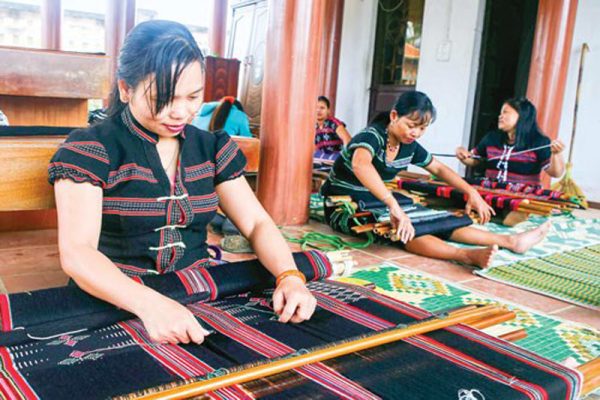THE ART OF ZENG WEAVING

Weaving is more than an art; it is a reflection. At first glance, zeng weaving appears to be a sophisticated marriage of colours in a wealth of motifs. Admittedly it is far from a simple weave and the Ta Oi people are masters of the technique. It demands not only skill, but patience, dexterity and attention to the minute details. The technique required to achieve this complex union of colour can not possibly be duplicated by machinery and dictates this remains a genuinely cottage industry. The dominant colour of zeng weaving is black, which forms the base of their designs and motifs. Surprisingly only five colours are used: blue, white, red, yellow and black. During the weave these colors are offset by artificial pearls. One of the features of this weave is the the fringes are adorned with small sparkling, spherical silver and copper bells. The woven motifs number about sixty in all and are valued as powerful cosmological symbols. Motifs often represent the universe of Ta Oi mythology to include spirits and genies. Others represent their oral history and legends that have handed down for a millennia. The symbolism involved in zeng weaving is a fascinating study. The ngkang kating motif for example; it assimilates the trunk of a secular tree with two zigzagging, yet parallel lines to represent the Parsee Slope (translated as the Slope of Love). This motif reflects the site of an unhappy love between a poor young man and the daughter of a rich man. The Leech of the Mountain motif is an image representing a cruel sorcerer in a children’s fairy tale. Some motifs represent culturally pertinent symbolism, for example the swallow’s tail, or a rooster’s frock. Other objects represented in the motifs are of everyday use like jars of hot chili, traditional hunting weapons and traps, or local flora and fauna. Like many other cultural representations around the world, Father Sky, Mother Earth and the North Star are also viewed in the woven motifs. Interestingly enough, mankind has no more than one fleeting representation as a spirited dancer in a popular festival. Like the Ta Oi people, all their weaves are environmentally friendly. The threads are made up of a unique variety of cotton obtained from the wild cotton plants called kapas. In A Luoi you can see the wild cotton transplanted to their mountain fields. Another one of their interesting and environmentally-friendly practices is the vegetable-based dying process, which they are quick to tell, is quite time consuming. The black and the blue colours are obtained from infusions of the tardon plant mixed with special shells. Yellow is produced from the roots of the dang dang plant which grows deep in the forest. When viewed objectively, it appears that the motifs are governed by geometric traits, which compliment the abstract style of the Ta Oi. The zeng weave of the Ta Oi people in A Luoi has come to the attention of both local and international designers. Today you can find decorative handbags, placemats and various types of scarves and souvenirs displayed in the handicraft shops of Hanoi and Ho Chi Minh City as well as exported to shops around the world. Photo: saigondautu.com.vn
|





